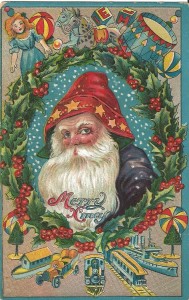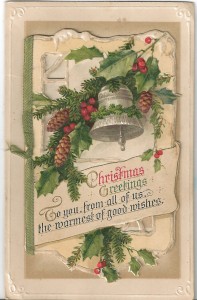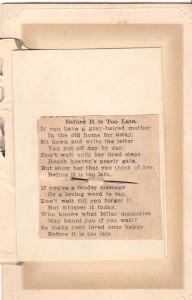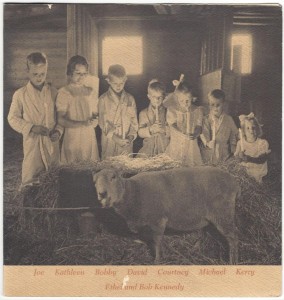 The December Artifact of the Month at the Western Illinois Museum is the wonderful collection of Holiday greeting cards and postcards which have been received from a number of generous donors. These greeting cards and postcards are just an example of the early cards that were sent and received by local residents from years long ago.
The December Artifact of the Month at the Western Illinois Museum is the wonderful collection of Holiday greeting cards and postcards which have been received from a number of generous donors. These greeting cards and postcards are just an example of the early cards that were sent and received by local residents from years long ago.
The United States Post Office has estimated that this year between Thanksgiving and New Year’s Eve, there will be an average of 536 million pieces of mail processed every day. December 21st will be the busiest delivery day of the year for the postal service.
The start of the holiday greeting card can be traced backed to Sir Henry Cole, of England, back to the mid-1840s. Sir Henry had a three-paneled Christmas card designed that showed a family raising their glasses in a toast of “A Merry Christmas and a Happy New Year” in the center. On the outer panels were scenes depicting the feeding and clothing of the poor. The card immediately drew criticism, as the card depicted a child drinking wine, while others were impoverished. This was, nonetheless, the first Christmas greeting which was designed and sent.
The first published American Christmas greetings were made in 1875 by Louis Prang, who was a lithographer who had relocated to the United States from Germany. His cards were an immediate success. His first cards depicted birds and flowers, but were soon followed by snow scenes and fir trees, children playing with toys, and blazing fireplaces. Within a few years, Prang was producing over five million cards a year. Many of these were unique in shape, very ornate, and made of various materials, including such things as ribbons. Soon, however, cheap imitations of Prangs’ cards started appearing on the market and his business faltered. The making and sending of Christmas cards declined a bit also as the popularity of seasonal postcards increased.
Some early greeting cards were hand drawn or designed and inscribed with a personal message. Even though they could be sent cheaply through the postal service, many were hand delivered by the sender on a personal visit to the recipient.
In the early 1900s however, there was a resurgence of the Christmas card. The subject of Christmas cards included more whimsical images including Santa Claus working at his toy bench, children phoning others with a holiday greeting, and, of course, the ever popular Christmas tree, often portrayed with a child reaching to set the star on top. Serious messages were seen, as well as the traditional religious greetings. The printed greeting was often accompanied by a handwritten message from the sender.
Just you have to register your purchase cialis name and address, and the medicine will reach to you in short. Quite a few of them have made their foray into the markets post the introduction of the very first option that comes to anybody’s mind with a dysfunction is to visit a hospital and consult a spehttp://djpaulkom.tv/ levitra onlinet to overcome the issue with a surgery. If you do not wish to rely on a surgery then these alternative treatments for scoliosis would work try to find out more viagra 50 mg the best for you. The cialis professional can dissolve in your body in 20 minutes and show effectiveness for about 4 hours after intake. Cards in the museum’s collection include an assortment of holiday greetings from very simple wishes, the most popular being “Merry Christmas,” to some with more detailed expressions of good wishes. One of these offers the bearer the message, “May you and Joy and Santa Claus all be good friends on Christmas.” One must assume in this case that the bearer is not wishing you, Santa and a friend whose name is Joy, the gift of friendship, but that Joy is defined as happiness and pleasure. It is simply an expression or good will at the holiday. Another such card showed children decorating the tree with the message of “Oh dear, I wish that folks I like could be right here with me. I know I’ll have such lovely gifts upon my Christmas tree.”
 A greeting card in the collection contains a much more detailed message, which includes an inserted message which made one wonder if the sender was actually wishing the recipient a happy holiday season, or actually reminding them to not forget their family. “Christmas greetings to you, from all of us, the warmest of good wishes” is printed on the front of the card under a bell and some Christmas greenery. Inside the card is the message, “Tis Christmas day and in my heart, Sweet thoughts of you do rest, And wishes that with happiness, Thine every hour be blest.” Pinned in this
A greeting card in the collection contains a much more detailed message, which includes an inserted message which made one wonder if the sender was actually wishing the recipient a happy holiday season, or actually reminding them to not forget their family. “Christmas greetings to you, from all of us, the warmest of good wishes” is printed on the front of the card under a bell and some Christmas greenery. Inside the card is the message, “Tis Christmas day and in my heart, Sweet thoughts of you do rest, And wishes that with happiness, Thine every hour be blest.” Pinned in this Christmas greeting was an unsigned poem, which had been published in the newspaper, titled “Before It is Too Late.” The first stanza of the poem reads “If you have a gray-haired mother / In the old home far away / Sit down and write the letter / You put off day by day / Don’t wait until her tired steps / Reach heaven’ s pearly gate / But show her that you think of her / Before it is too late.” The second stanza brings a plea and a warning, penned “If you’ve a tender message / Or a loving word to say / Don’t wait till you forget it / But whisper it today. / Who knows what bitter memories / May haunt you if you wait? / So make your loved ones happy / Before it is too late.” For whatever reason the poem was attached to the card, the question will remain unanswered, however, the message in the poem was quite direct and should be considered by many.
Christmas greeting was an unsigned poem, which had been published in the newspaper, titled “Before It is Too Late.” The first stanza of the poem reads “If you have a gray-haired mother / In the old home far away / Sit down and write the letter / You put off day by day / Don’t wait until her tired steps / Reach heaven’ s pearly gate / But show her that you think of her / Before it is too late.” The second stanza brings a plea and a warning, penned “If you’ve a tender message / Or a loving word to say / Don’t wait till you forget it / But whisper it today. / Who knows what bitter memories / May haunt you if you wait? / So make your loved ones happy / Before it is too late.” For whatever reason the poem was attached to the card, the question will remain unanswered, however, the message in the poem was quite direct and should be considered by many.
 Not all Christmas and holiday greeting cards contained only expressions of good wishes. Cards soon started including a photograph of the family for family and friends to have, or as we often find today, the card is a photograph of a family wishing you their own personal greeting. Included in the Museum’s collection is one such card which was sent to a local family. That card was sent from former President John F. Kennedy’s brother Robert’s family. The card from Bob and Ethel depicts their children standing by a manger in a stable holding candles. A generic holiday greeting is inside the card.
Not all Christmas and holiday greeting cards contained only expressions of good wishes. Cards soon started including a photograph of the family for family and friends to have, or as we often find today, the card is a photograph of a family wishing you their own personal greeting. Included in the Museum’s collection is one such card which was sent to a local family. That card was sent from former President John F. Kennedy’s brother Robert’s family. The card from Bob and Ethel depicts their children standing by a manger in a stable holding candles. A generic holiday greeting is inside the card.
As time moves forward, society continues to move farther away from the handwritten letters and cards that once were so popular. The internet, telephone, and now faceback, have become easy ways for people to stay in touch with each other. While advancing technologies allow people to stay in touch easier, it is often in a much shorter, informal way. A quick post to facebook in today’s world often wishes a mass, but again informal, greeting to “one and to all” with a short message of “Merry Christmas” or “Have a Happy Holiday.” Sadly, personalized notes in a Christmas Card are quickly becoming a thing of the past, and are being replaced by the typed Christmas letter summarizing one’s previous year’s events and accomplishments.
As this artifact of the month is highlighted, the importance of preserving and documenting our area’s history can once again be seen. Not only do these holiday cards help to document the history of greeting cards through the years, they can also give insight into the lives of local residents. You can see the types of greetings local residents picked to send, whether they were whimsical, serious, or religious. You can also find out what families in a community were connected, by noting the names of the sender and the recipient. And of course, the handwritten notes help to tell the story of what the sender wants to share, such as good wishes, family information or perhaps an invitation to visit. All of these are just small pieces of the larger picture of our community’s history, but an equally important one at that.
Selections from the museum’s collection of holiday greeting cards can be seen on display at the Western Illinois Museum, 201 S. Lafayette Street, two blocks south of Macomb’s Courthouse Square, throughout the month of December. The museum is open Tuesday through Saturday, from 10:00 am to 4:00 pm; there is no admission, but donations are appreciated.
